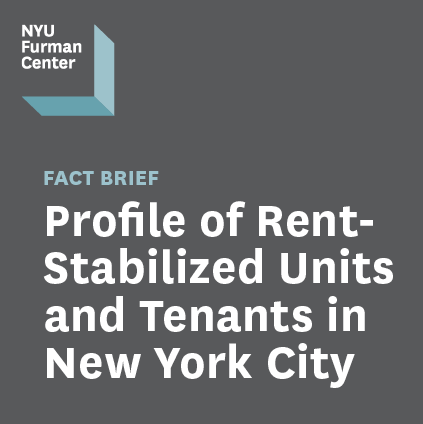
NYU Furman Center Brief Examines Tenant Characteristics in NYC’s Stabilized & Market-Rate Housing

In 2011, rent stabilized units comprised nearly one million units of housing in New York City—roughly 45 percent the city’s rental housing stock. The NYU Furman Center released a fact brief today that details characteristics about the socioeconomic and demographic characteristics of the tenants who live in stabilized housing.
 The fact brief, Profile of Rent Stabilized Units and Tenants in New York City, is an update to a 2012 Furman Center brief. It has been slightly expanded and re-released to inform the ongoing discussions about rent stabilization in New York City in advance of the June 23, 2014 Rent Guidelines Board vote to set the allowable increase for next year’s lease renewals.
The fact brief, Profile of Rent Stabilized Units and Tenants in New York City, is an update to a 2012 Furman Center brief. It has been slightly expanded and re-released to inform the ongoing discussions about rent stabilization in New York City in advance of the June 23, 2014 Rent Guidelines Board vote to set the allowable increase for next year’s lease renewals.
According to the brief, rent-stabilized housing serves many low-income New Yorkers. In 2011, roughly 66% of tenants living in rent-stabilized units had ‘low incomes’ (less than $58,950 in 2011) compared to roughly 54% of tenants of market-rate units.
In Manhattan, the difference in income levels of households living in rent-stabilized units and those living in market rate rental units was striking. The typical household living in a market-rate rental unit in 2011 had an income more than double that of the typical household living in a stabilized unit.
Rent-stabilized units also house a greater share of households led by seniors. Citywide, over 23% of rent-stabilized households are led by a senior, compared to just 7% of market-rate households. In addition, citywide, stabilized units house a greater share of minority households, though the shares range significantly by borough. In Manhattan, for example, 52% of rent-stabilized households were non-white, compared to just 27% of market-rate rental households.
The brief also finds that contract rents for stabilized units were significantly less than contract rents for market-rate units in 2011. In 2011, stabilized units rented for about $1,235 per month less than market-rate units in core Manhattan (which includes community districts MN 01-08) , but only $228 less than market-rate units outside of core Manhattan.
"Lower rents for stabilized units may have, over time, helped to ease the rent burden for some of our city's most vulnerable residents," said Max Weselcouch, Director of the Moelis Institute for Affordable Housing Policy at the NYU Furman Center.
"Still, these data do not tell us what would happen if we did away with rent stabilization, or the potential impact of the range of rent increases under consideration by the Rent Guidelines Board--including a rent freeze."
___________
Read the fact brief or view the June 17, 2014 press release.


